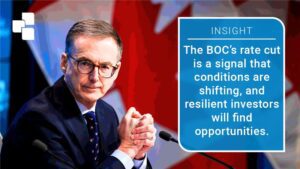Canada’s Real Estate Capital Crunch: Navigating an Unprecedented Uphill Battle

Sponsored Post: Axiom Advisors
Canada’s Real Estate Capital Crunch: Navigating an Unprecedented Uphill Battle
For years, the Canadian real estate market felt like a sure bet. As developers, investors, and homebuyers, we operated within a relatively predictable ecosystem where capital was accessible, projects were launched, and growth seemed constant. But that era has come to an end. Today, raising capital for real estate projects in Canada isn’t just a little tougher—it’s an unprecedented uphill battle, characterized by a series of compounding challenges that have slowed our industry to a crawl.
This capital crunch is not a simple problem with a simple solution. It’s a complex web of economic, market, and regulatory pressures that are keeping us up at night. However, amid this turmoil, a powerful and often overlooked solution is emerging: leveraging registered funds through a strategically structured investment vehicle known as a Mutual Fund Trust (MFT). This approach is not merely a workaround; it’s a future-facing strategy designed to not only survive but thrive in the new Canadian real estate landscape.
The Perfect Storm: Why Traditional Capital Has Dried Up
To understand why a new approach is necessary, we first need to understand the forces that have dismantled the traditional fundraising model. It’s a perfect storm of factors, each feeding into the next to create a near-impenetrable wall for many of us.
1. The Pre-Sale Precipice: A Chilled Market
Pre-construction condo sales have long been the lifeblood of urban development, particularly in high-demand markets like Toronto and Vancouver. We rely on a certain percentage of these sales to secure construction financing from traditional lenders. But in the current market, that lifeline has been severed.
In early 2024, the pre-construction condo market saw a dramatic slowdown, with sales plummeting by over 50% in major cities compared to the previous year. This wasn’t just a blip; it was a fundamental shift. Potential buyers, facing economic uncertainty, high interest rates, and a sense of market fatigue, have retreated to the sidelines. For us, this has created a critical impasse. Without the required pre-sale thresholds, banks simply won’t release construction funding, leaving our projects stalled in a state of indefinite limbo.
2. Bureaucratic Hurdles: Permits and CMHC Delays
Even with capital in hand, our path to a shovel in the ground is fraught with delays. The Canadian Home Builders’ Association (CHBA) has consistently highlighted how slow and inefficient municipal permitting processes are a major barrier to new construction. Studies show that Canada ranks well behind most other Organisation for Economic Co-operation and Development (OECD) countries when it comes to the time needed to obtain necessary permits. In some major urban centers, the average approval time for a new project can stretch for months, and even years, adding significant costs and uncertainty. These administrative delays are a prime reason why our projects stall, regardless of funding.
Furthermore, while the Canada Mortgage and Housing Corporation (CMHC) is a key player in housing finance and market stability, we often face additional complications when navigating its processes. CMHC’s mortgage loan insurance is a cornerstone of the housing market, but for new construction, the detailed review and approval process can add to our project timelines. For projects aiming for CMHC financing or CMHC’s direct-lending initiatives, the required due diligence and documentation can be extensive. Any discrepancies or missing information can lead to further delays, creating a domino effect that impacts our project timelines and financial projections.
3. Housing Starts and the Supply-Demand Gap
The decline in pre-sales and the bureaucratic hurdles have a direct and alarming impact on the national housing agenda. The Canada Mortgage and Housing Corporation (CMHC) has warned that housing starts are projected to decline for the third consecutive year. This is a significant setback for a country with a chronic housing supply shortage. CMHC has estimated that Canada needs to nearly double its annual housing starts to 430,000-480,000 units per year until 2035 to restore affordability. The current pace of decline suggests the opposite is happening.
This challenge is a double-edged sword. On one hand, the lack of new supply continues to drive up prices for existing homes, perpetuating the affordability crisis. On the other, it creates an immense opportunity for us to find a way to circumvent the capital crunch and bring new projects to market. The demand for housing, particularly rentals, remains robust due to strong population growth and elevated homeownership costs. The problem isn’t a lack of demand; it’s a lack of funding and a slow, painful process to meet that demand.
4. Rising Distress and Insolvencies
The pressure isn’t just on new projects. Many of us are struggling to stay afloat. A surge in insolvencies and high-profile projects going into receivership has sent a clear message: the foundation of our industry is shaking. This distress is a direct result of the elevated costs of borrowing and a difficult sales environment. We took on debt in a low-interest-rate world and are now facing crippling renewal costs. This instability makes traditional lenders even more risk-averse, tightening the spigot further for both new and existing players.
5. The Squeeze from All Sides: Costs and Labour
Beyond the capital itself, we are contending with persistent inflation in construction costs and a chronic labour shortage. The cost of materials has continued to rise, and an aging workforce means there aren’t enough skilled tradespeople to complete projects on time. According to forecasts, over 245,000 construction workers are expected to retire by 2032. This growing labour gap, combined with soaring wages, results in longer construction timelines and increased project risk, further deterring traditional financiers.
This perfect storm of pre-sale declines, bureaucratic delays, financial distress, and escalating costs paints a bleak picture for anyone relying on traditional lending. The old models no longer work, and a new, more resilient strategy is required to access the capital we need to fuel the next generation of development.
A Powerful Alternative: Tapping into the Trillion-Dollar Capital Pool
While traditional capital routes are drying up, an immense reservoir of wealth remains largely untapped for real estate development: with an estimated 5 to 10 trillion dollars held in registered funds like RRSPs and TFSAs. Most investors and even many of us as developers don’t realize we can legally and effectively use this capital for private real estate projects.
This is where the paradigm shifts. Instead of trying to squeeze capital from risk-averse banks or a chilled public market, we can directly access a massive, tax-optimized pool of investor money.
Here’s why registered funds are a superpower right now:
- Massive Capital Pools: Canadians have a staggering amount of money sitting in these accounts. By opening up our projects to this funding source, we’re not just getting a loan; we’re attracting a diverse and vast pool of investors.
- Tax-Optimized Growth: For investors, the appeal is immense. When they invest their registered funds, their returns grow tax-free (in a TFSA) or tax-deferred (in an RRSP). This tax efficiency makes even modest returns highly attractive and provides a powerful incentive for investors to move their money out of traditional, low-yield public markets and into tangible real estate assets.
- Efficient Capital Raises: The numbers speak for themselves. In a recent case study, a client of Axiom Advisors raised over $27 million from just 189 investors using registered funds. That’s a capital juggernaut with far fewer moving parts than a
conventional raise, streamlining the entire process and reducing the administrative burden.
Case Study: Actual Registered Investment Statistics
Axiom manages the administration for many of the Mutual Fund Trusts (MFTs) that we create for our clients, giving us a firsthand view of how attractive they are to investors who want to use registered funds.
Many of our MFTs have above 95% of their investments from registered funds. On the low end, one of our MFT Issuers has a 64% registered fund investment rate. This MFT has several other projects, and many of the investors are using their registered funds across those projects. Even at this “low” rate of 64%, it represents $3.2 million on a $5 million raise, which is not a bad start to the capital raise.
Another of our clients has raised over $65 million from 256 different investors. Of these, 189 (74%) used registered funds. Many of these investors also contributed from non-registered accounts because they had already invested all their registered funds. Additionally, six investors were over 71 years old and used cash to invest in order to comply with the requirements to withdraw their RRSP investments. This Issuer also received investments from corporations whose owners, for the most part, were either over 71 or had already used their registered funds. This leaves only about 6% who used cash, and we couldn’t confirm their ability to invest using registered funds.
The Key to Unlocking This Capital: The Mutual Fund Trust (MFT)
So how do we legally access this trillion-dollar pool? The answer lies in a specific, CRA-recognized structure: the Mutual Fund Trust (MFT).
An MFT is a tax-efficient investment vehicle that acts as a conduit, allowing us to raise capital from registered funds while providing a secure, tax-advantaged way for investors to participate. The trust itself is not taxed on its income; instead, the profits “flow through” directly to the investors, where they are taxed according to the investor’s individual circumstances. This flow-through treatment is a massive advantage over a traditional corporate structure, which often leads to double taxation (at the corporate level and again when income is distributed to shareholders).
However, not just any trust will do. To qualify as a Mutual Fund Trust with the CRA, we must meet a specific and often challenging requirement: the 150-unitholder rule. Each MFT must have at least 150 investors that invest at least $500 in a single class of units by the end of March of the following tax year. This is a tough requirement to meet. Very few of our MFTs
would meet this requirement on their own. Axiom will ensure that you meet this requirement so that you can focus on raising capital and running your project.
The Axiom Solution: Segmented, Scalable, and Compliant
The real genius of the Axiom Advisors model lies in our innovative approach to the traditional MFT model. Instead of creating a new MFT for every project, we developed a segmented MFT model—a single, master trust that can house multiple, distinct projects under one umbrella.
Here’s how it works:
- The master trust is set up with multiple “classes” of units.
- Each class corresponds to a different project or asset type. For example, Class B for a condo development, Class C for a land acquisition, and Class D for a rental building.
- Each project is “siloed,” meaning an underperforming asset in Class B will not affect investor returns in Class C. This is a critical risk-mitigation feature that enhances investor confidence.
This segmented model elegantly solves the biggest challenge of MFTs, ensuring compliance from day one while providing us with an infinitely scalable structure. As developers, we can continue to launch new projects under the same trust without the headache of re-establishing a new entity and re-qualifying for the 150-investor rule each time.
Beyond the Structure: A Full-Service Partnership
Setting up the right legal structure is only the first step. The process of raising capital, onboarding investors, and maintaining compliance is complex. This is where Axiom’s full-service approach provides invaluable support.
- Investor Relations and Onboarding: Attracting investors is one thing; keeping them happy is another. Axiom streamlines the entire process, handling everything from digital forms and documentation to ongoing communication and automated payments. A smooth and transparent investor experience builds trust and encourages repeat investment.
- Securities Law Compliance: The world of private capital is governed by strict securities regulations. We can’t just advertise to the public; we must adhere to rules regarding who we can sell to (e.g., accredited investors) and what documents we need (e.g., Offering Memorandums, Subscription Agreements). Axiom works with legal and regulatory experts to ensure every step—from drafting a promissory note to marketing the investment—is fully compliant, protecting both us and our investors from legal pitfalls.
- The Exempt Market Dealer (EMD) Network: For a successful capital raise, partnering with an EMD is a must. These registered securities dealers are experts in the private capital market. They can vet potential investors to ensure they qualify for specific exemptions and handle the necessary paperwork. Axiom’s network of EMDs provides a seamless path to connecting with qualified investors and ensuring a legal, compliant fundraising process.
- Cost-Effective Models: The upfront cost of setting up an MFT can be a barrier for some. Axiom offers flexible cost pricing to make the solution accessible. Their “Full Ownership” model is ideal for larger projects, while a “Rent-to-Own” model with a lower initial deposit makes the structure accessible to developers with smaller, initial capital raises.
The Bottom Line: A Strategic Lifeline for a Challenging Market
In the face of stalled pre-sales, rising defaults, and a relentless capital crunch, relying on traditional sources is a recipe for stagnation. The Canadian real estate market is crying out for a new model, one that can bypass the traditional gatekeepers and tap into a powerful, tax-efficient source of capital.
A Mutual Fund Trust, when structured correctly, is not just an alternative; it’s a strategic lifeline. It offers us the ability to:
- Raise Significant Capital Efficiently: Access the multi-trillion-dollar pool of registered funds.
- Ensure Compliance and Mitigate Risk: Navigate complex CRA and securities regulations with a single, compliant structure.
- Scale Without Limits: Launch an unlimited number of projects under one umbrella, eliminating the need to start from scratch for each new venture.
- Build Investor Confidence: Offer a tax-efficient, legally sound, and professionally managed investment vehicle that protects and grows our investors’ wealth.
The future of real estate development in Canada belongs to those of us who are willing to adapt. By embracing a forward-thinking investment strategy like a segmented MFT, we can unlock the capital we need to build the housing Canada so desperately needs, transforming a seemingly insurmountable challenge into a powerful competitive advantage.
CONTACT US TODAY AT AXIOM ADVISORS TO LEARN MORE.
Recent Blogs
From Confusion to Clarity: The 5 Steps to Confident Real Estate Investing
You’re ambitious. You’re driven. You’re juggling a busy career, maybe a family, and you know you should be making your…
Upsizing Smart: Turn A Single-Family Home Into A Duplex (And Use Your Equity To Buy Your Next Property)
By Harris Newman, Mortgage Agent L2 – EZ Mortgage Solutions Why “Upsize” Now? If you love your neighbourhood but need…
The 6 Timeless Principles Every Successful Real Estate Investor Follows
SPONSORED CONTENT: Referral Network Realty Referral Network Realty is extremely grateful to have been partnered with Keyspire for over a…
Take Aways from the Bank of Canada’s Rate Announcement
The Bank of Canada announced a quarter-point rate cut today, and while small on paper, it carries important signals…




